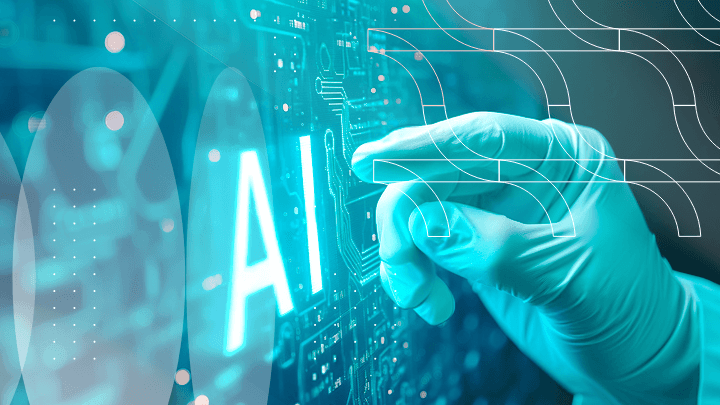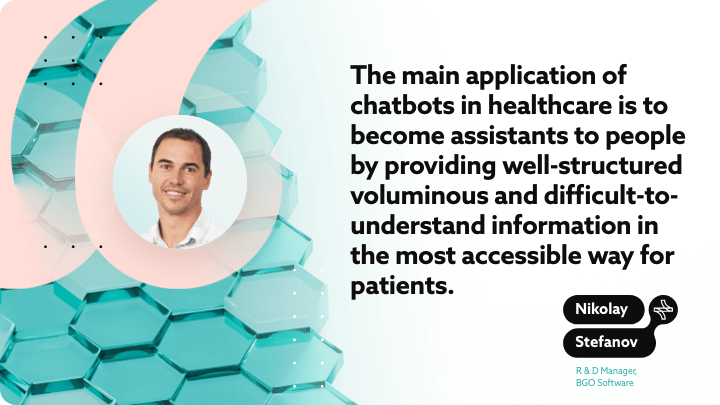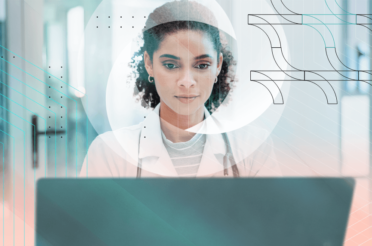In most industries, creating and deploying a chatbot is straightforward. However, it has become more complex in healthcare institutions due to handling sensitive patient information, diagnoses, prescriptions, and medical advice.
Errors made by chatbots in these areas can have serious consequences. Therefore, how can healthcare organizations use AI chatbots without compromising patient data and care quality?
Healthcare organizations aim to enhance their services and offer dependable, personalized medical services. By leveraging AI chatbots, healthcare providers can significantly improve patient experiences and empower their health literacy with real-time, seamless self-service assistance.
These chatbots assist patients by providing 24/7 access to medical assistance and streamlining processes like appointment scheduling,booking, rescheduling, and canceling doctor appointments, initial guidance and not risky recommendations, healthy habits creation process, etc. Within the healthcare industry, chatbots play a crucial role in patient engagement and operational efficiency thus transforming the patient care experience.
They allows medical professionals to focus their efforts to more complex tasks where their expertise is most needed. This article will discuss key challenges in implementing AI technologies, specifically chatbots, in healthcare.
We feature insights from our expert Nikolay Stefanov, R&D Manager eHealth & AI.
What is a healthcare chatbot?
Healthcare chatbots are intelligent assistants in medical centers, and medical professionals use them to help patients get assistance faster.
The simple term “chatbot” covers the much more powerful nature of the technology behind – being easily coupled with with complex mathematical models, extrenal tools or an extensive database, they can interact with patients and assist with:
- Answering frequently asked questions;
- Scheduling appointments for healthcare services;
- Reminders and other repetitive questions;
- Queries that often overload medical offices, and others.
- Find relations in factors and symptoms that may look not connected at first glance
- Provide not risky recommendations, etc.
Chatbots use so-called Large Language Models (LLM), which enable the extraction of the meaning from data rather than just learning it. These algorithms allow the creation of dependencies between words in the text and the correlation between them. This is also why AI can pick up and complete our sentences when typing – “guessing” very well what we are aiming to write, and not just completing a next work.
As an expert, Nikolay explained:
“Just as humans wrap words in meaning, AI uses the digital representation of those words and the correlation between them to create mathematical connections and build the same idea of meaning as we humans do. If making this “parallel” sounds strange, just look at how we create amazing novels & stories out of the “weird” and stupidly simple alphabet letters:)”
When a model is trained with a lot of information, the actual meaning of a word does not matter as an understanding; the dependencies and probabilities between individual words make sense to an AI similar to what humans input.
However, this learning approach is more familiar than you might think. Similar algorithms have been observed since machine learning began in the 1950s.
“Training AI chatbots with LLM is a difficult and computationally demanding task. Thus, technical capacity is needed to build and make this process scalable. AI became more accessible as hardware became more affordable and widely available. These neural networks can be large enough to hold all the data and regulate the operations to be employed immediately in real-time once the hardware is produced.”
What is the hardest thing about healthcare?
The “hardest” factors are not a few:
- It takes years of complex study and several specializations to grasp one part of medicine.
- Then the specialists are figuring out several hidden dependencies that have to be considered
- Then the corner cases are coming
- Then the science discovers new factors…and all starts over again.
Machine learning models in healthcare, however, collect and organize digitized medical data from various sources. This systematic approach enables them to provide very reliable and specific answers.
Therefore, by asking a specific question to a chatbot, we can quickly obtain accurate information on a medical issue, thanks to the extensive data used to train the AI.
“While human brains can absorb a large amount of information, it takes time and systemic upgrading to create neural connections and become competent in a given area, but the human’s life is short, while the speed of gathering data in our minds is limited…The perfect place to use artificial intelligence would be in healthcare. With the abundance of information, we can feed AI, and it can serve as a powerful virtual assistant that empowers us to manage and process complex medical data, helping us to breach our biological limits and empowering or “global picture” strengths.”
Types of chatbots in healthcare
Healthcare chatbots, whether integrated into messaging services like Facebook Messenger, WhatsApp, or Telegram or as standalone applications, can be classified into three main types.
Each type has distinct characteristics that define its functionality:
- Informative chatbots provide users with guidance and informational support, typically through pop-up messages. They offer a non-intrusive way to introduce patients to medical knowledge, making them ideal for mental health support or addiction rehabilitation services. Informative chatbots utilize basic AI algorithms to deliver information via pre-set responses. Many patients interact with these virtual assistants to address mental health problems and emotional health concerns.
- Conversational chatbots are designed to address patient concerns better, and they can respond to specific questions. They utilize Natural Language Processing (NLP), a subclass of machine learning algorithms, to process speech, plus Text To Speech (TTS) algorithms that allows performing a normal human-like conversations.
These bots require training before deployment and can continue learning from user interactions, improving their effectiveness. - Prescriptive chatbots are advanced chatbots that go beyond simply answering questions by providing medical advice based on user-provided information. They employ NLP, TTS (and many other complex algorithms), plus are being provided with access to the latest medical knowledge & databases. The level of responsibility of these chatbots is the highest one, as they must be adhering to ethical guidelines, comply with regulations, consider per-patient specifics and analyze complex symptomps, metrics & factors..
Use cases of health chatbots
What makes machine learning models effective? It is the ability to focus on a specific field of medicine sets LLMs apart and contributes to their efficacy for the healthcare sector.
According to the expert Nikolay, it’s almost impossible to have a general-purpose medical AI as this assumes that we have all the information about medicine, which is impossible as not all medical textbooks are digitized.
Moreover, there is no way to upload all patient records to the web, cover them, and address all the problematic medical scenarios in the practice of doctors.
The use of chatbots in telemedicine
Chatbot technology has multiple ways to improve virtual healthcare and remote medical care, including in the field of telemedicine. Below are a few cases in which medical chatbots are enhancing patient care during the delivery of health care from a distance.
Integration of chatbots in emergency response
Chatbots can be deployed at any phase of an emergency call, seamlessly collaborating with dispatchers by gathering critical information and promptly relaying it to the appropriate emergency services.
“Telemedicine in emergency care, combined with AI, can be integrated throughout the entire process—from receiving an emergency signal to the physical intervention of a doctor. If there is data to process, an AI bot can adjust it based on the reader’s needs, as AI understands the fundamental meaning. The language or method of visualizing the information does not matter.”
Medical documentation and knowledge management
Chatbots can summarize and organize data and documentation regarding new medical developments within specific fields, ensuring up-to-date information is readily accessible.
“Interpreting medical literature is a daunting task. Countless articles and research papers are published daily, making it impossible for anyone to review them all. However, this is fine for specialized LLMs. These AI algorithms can be programmed to collect and process this information, providing doctors with filtered and summarized information about all news in a given medical field, relieving them of the overwhelming literature review task.”
Comprehensive patient data analysis
Chatbots excel in collecting and analyzing patient data, filtering through vast amounts of information to deliver personalized insights.
This capability significantly reduces misuse of medical pathways and fraud within the National Health Insurance Fund (NHIF).
They have enhanced patient qualifications
AI-driven chatbots can be trained to evaluate patients’ conditions by scrutinizing medical records, X-rays, tests, and past treatments. This thorough assessment helps ensure that diagnoses and scheduled hospital pathways are appropriate, making it considerably more challenging to exploit health fund resources.
Chatbots may access and update patient information within electronic health records, maintaining accurate and current records.
Benefits of AI chatbots for patients
From improved patient outcomes to better health service and faster medical appointments – below, we will list how chatbots are helping patients enjoy a better healthcare system.
-
Improving accessibility to healthcare
Patients can get answers to their queries using chatbots regardless of the time of day.
Access to patient information about their symptoms, medications, and treatment options allows them to make informed decisions about their health.
-
Appointment arrangements
Chatbots make visit management, booking, rescheduling, and canceling doctor appointments more accessible for patients. People can now list their symptoms on the chatbot and may receive timely information on whether they need a visit to healthcare facilities.
Patients frequently have to get ready before a diagnostic appointment or test. An AI chatbot can assist by providing automated messages, as well as pre-appointment videos, images, and advice.
The Chatbots may reorganize the patient’s information in various ways, making it well-formed for the various types of specialists that will use it
-
Medication reminders
Chatbots can send reminders to patients to take their medications on time, which improves adherence to prescribed treatments and overall health outcomes.
Furthermore, Nikolay Stefanov shares:
“What’s more, the conditions added to the chatbot can accumulate answers to precise queries like…I missed taking my medicine two days in a row. Can I start retaking it? Will it hurt me?”
-
Chronic disease management
Healthcare chatbots can provide ongoing support and helpful content to patients with chronic conditions, helping them understand how to manage their condition more effectively. Starting an educational campaign may help increase public knowledge about diseases and their treatments.
Particularly before the flu season, it can be useful to launch educational campaigns to tell patients about how to avoid getting colds and the flu, how to spot breast lumps, and how to recognize the symptoms of a woman’s heart attack or stroke
-
Privacy and comfort
Some patients may feel more comfortable discussing specific health issues with a chatbot because their interactions are private and confidential.
When there is emotion, and the patients’ fears are more substantial, this hinders communication and engagement between patients and healthcare workers. This leads to the problem that patients do not share with doctors and hide symptoms or do not seek help at all, making diagnosis and treatment difficult.
AI assistants are ideal in such cases because they provide a safe space for patients by excluding emotional and stressful factors. People can share their problems and ask questions that concern them without worrying that they will be criticized, ridiculed, or ignored, knowing that they will get a summarized and informative answer without waiting for a long time.
Advantages for doctors and healthcare professionals
Healthcare chatbots offer numerous benefits to healthcare professionals, greatly improving their ability to deliver effective care.
Chatbots can handle routine patient inquiries, freeing the medical professional to focus on more complex cases. AI assistants are helping reduce the workload of health practitioners by handling repetitive and administrative tasks, mitigating burnout, and allowing them to focus on patient care.
Using chatbots to schedule doctor appointments frees both the patient and the healthcare provider from the administrative burden. This allows patients to save time and not stand in queues to book an appointment with a doctor or wait on hold on the phone. Also, through chatbots, healthcare companies can create different plans for patients with chronic diseases, create educational content about their patients’ diseases and actively participate in their treatment without constant supervision.
Chatbots can collect patient information, catalog it, store it, and filter it. This further facilitates diagnosis and provides quick and easy access to patient data. After providing the necessary patient information, chatbots can triage patients, direct emergencies to medical facilities, and give directions to others.
In addition, healthcare chatbots can present a patient’s medical history and past procedures, helping doctors coordinate current and future treatments. The records can be integrated with electronic health records (EHRs) to provide accurate and up-to-date patient data.
What are the benefits for businesses?
Patients are increasingly appreciating the value of individualized treatment provided by programs like chatbots, viewing them as essential rather than optional. Organizations and healthcare facilities that use this technology are probably going to benefit in the long term. The beneficial changes in patient-AI chatbot relationships result from the valuable services that this innovative tech may provide.
Chatbots provide round-the-clock assistance, answer patient queries, and offer support, which increases patient satisfaction. In turn, medical companies using the technology save money because AI chatbots do not need food, sleep, or money.
Chatbots can perform automated scheduling, such as handling appointment bookings, cancellations, and reminders. Reducing the administrative burden and minimizing scheduling errors results in additional patient traffic due to more accessible enrolment. Patient engagement has also increased as a result of the recognised improvement in prescription health pathway openness.
“AI can be trained on an algorithm to determine the severity of a patient. If digital data is available, classification and severity grading can be added in many medical fields. We must note that making a classification, analysis or a recommendation is much different than performing a final action after strong decision – so the AI can only serve as an independent evaluator but cannot make decisions. Maybe in the future, after AI technology advances, it will become reliable enough even to have the right to take action. For now, it is sufficient for AI chatbots to support and compliment the medical professional’s decision-making, saving their efforts and time for the most important things.“
The ethical side of AI chatbots in healthcare
Following the expert opinion, chatbots are invaluable for analyzing symptoms and collecting patient data, but doctors remain firmly responsible for giving medical diagnosis and prescribing treatment. AI needs “more expertise” to make these critical decisions. While AI chatbots serve as tools to aid specialists and streamline their work, the human element remains paramount.
Doctors, not chatbots, hold the legal and ethical responsibility for patient care. This reality can reassure patients but also makes some medical professionals cautious about integrating AI into healthcare.
Despite this, AI chatbots are becoming indispensable in healthcare institutions, enhancing efficiency and reducing staff workload. Although we may eventually see AI assisting in diagnoses and prescriptions, this is a complex challenge. Mastery of ethical training for chatbots is essential to ensure they handle sensitive patient information responsibly and provide high-quality medical services without human oversight.
AI algorithms for healthcare chatbots must be developed with strict ethical standards, ensuring they are unbiased, inclusive, and free from stereotypes or discrimination. These chatbots must undergo rigorous testing to meet these criteria before engaging with patients. As AIs’ impact on healthcare grows, it is crucial to monitor these tools for sensitivity issues and ensure they provide appropriate medical advice.
It should also be noted that a medical chatbot designed for patients may differ from a more specialized one for medical professionals. The way of presenting information and the data with which the two AI models were trained can vary. AI chatbots are created by programmers who possess the necessary knowledge of reputable medical professionals, as it is unrealistic to expect the average individual to comprehend sophisticated medical words.
This begs the question: How can doctors ensure that a healthcare chatbot covers a broad range of information understandably? How many possible situations can they come up with an answer to cover the patient’s questions afterward?
So the moral question is: Whose responsibility is it to doctors relying on AI to handle patient questions or to the tech company that developed the chatbot? The more quality information developers deliver to the AI, the more accurate it will be.
Discover how we can help outsource Healthcare projects efficiently Speak to an expert today, and see how our on-demand IT talent and augmented teams can efficiently deliver value at every step of your roadmap.

What are the obstacles in front of healthcare chatbots?
Three central problems can affect the accuracy of chatbot answers. The expert in eHealth & AI, Nikolay Stefanov, states that when creating an AI chatbot, the information that will be entered into it must be carefully selected:
“When language models are loaded with information, the data must be well-selected and qualitative. Otherwise, AI can be corrupted by wrong intentions, and it will not be useful anymore.The process is very similar to how you teach your child – the better and unbiased you are, the better he/she will grow.”
The first main issue is that outdated or incomplete information can lead to entirely wrong and even, in some cases, dangerous answers, which some people complain about when polling with chatbots. When a chatbot gives us the wrong information, it is because the AI was unaware of such information until that moment, or it was presented with incorrect data from the beginning.
Feedback is almost always created after an answer from AI. After loading a certain number of correct results produced by the AI chatbot, a feedback link with reasoning is returned to AI, where the markers determining the truth of the generated answer are shown. As a result, the AI starts to consider the reasoning every time it generates a response in this direction. This procedure is called continuous training, leading to the second big problem: providing false and misleading feedback information damages the data quality. It can spread the problem on a larger scale.
The third concern is the privacy of sensitive patient information. For patients to feel safe while talking with the healthcare chatbot, developers should ensure that the messages between users and the AI are secured and compliant with local regulations.
The future of healthcare chatbots
Personalized medical assistance will be able to be integrated into more products. Nowadays, almost everyone has a smart device, and there is no technological problem with virtually any such device running an application powered by artificial intelligence. Therefore, we can have a personal AI monitoring our health.
Our “personal AI doctor” may send reminders about taking medications, upcoming doctor appointments, etc. This would be especially helpful for older adults who forget to take their medications.
Specialized chatbots will also be created. Examples include diagnostic chatbots for checking symptoms and interpreting lab results ormental health chatbot solutions for mental health assistance and counselling.
“A comprehensive process of delivery of AI services is created for the various involved parties, from patient data collected by AI chatbots to their use by medical doctors to diagnose and treat conditions and search scientific literature through AI to the creation of patient programs and clinical trials for new drug and treatment developments,” says Nikolay Stefanov.
Conclusion
While the hardware supporting machine learning models is crucial, the real challenge lies in the data quality used for training. It’s paramount to be discerning and ensure that AI is trained with high-quality, dependable information.
According to Stefanov, this is a crucial step in avoiding potential pitfalls and ensuring the reliability of AI in the medical field:
“The technology behind the “chatbots” can be tailored to every specific medical tasks involving images, video, audio, text files, genetics related, graph or every other data types… we, the humans are with enough experience to accurately define a problem, organize the data into well formed structures and finally train highly effective specialized AIs”


















